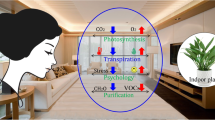Abstract
The effects of poor indoor air quality and mould growth in working environment are major problems in built environment, and there is a need to look for improvement of the health, comfort and productivity of the building occupants. Airborne mould sampling studies were conducted in a reference building located in Rockhampton, Central Queensland, Australia. Both indoor culturable and mould spore levels were observed. It was found through the indoor–outdoor ratios of the species that indoor concentrations are mostly related to the outdoor mould levels. The moulds differ in their relative humidity and temperature requirements to support surface growth. Indoor humidity has a significant effect on occupants comfort, perceived air quality, occupants’ health, building durability, emissions and energy efficiency. Practical hygrothermal simulation models are employed to analyse the combined heat and moisture behaviour within the built environment. A review of the current modelling options available to predict building performance based on energy and mass transport simulation is presented, and then a case study is presented with the assessment of indoor built environment to avoid mould problem.






Similar content being viewed by others
References
Adhikari, A., Sen, M. M., Bhattacharya, S. G., & Chanda, S. (2004). Airborne viable, non-viable, and allergenic fungi in a rural agricultural area of India: a 2-year study at five outdoor sampling stations. Science of The Total Environment, 326(1–3), 123–141.
ANSI/ASHRAE Standard, 5. -1. (1992). Thermal Environmental conditions for human occupancy. Atlanta: American Society of Heating, Refrigerating and Air-Conditioning Engineers, Inc.
Baughman, A. V., & Arens, E. A. (1996). Indoor humidity and human health — Part I: Literature review of health effects of humidity-influenced indoor pollutants. ASHRAE Transactions, 102(1), 193–211.
BOM (2007). Climate Information. Retrieved from Bureau of Meteorology: http://www.bom.gov.au/climate/.
Burge, H. A., Pierson, D. L., Groves, T. O., Strawn, K. E., & Mishra, S. K. (2000). Dynamics of airborne fungal populations in a large office building. Current Microbiology, 40, 10–16.
Clark, N. M., Ammann, H. M., & Brunekreef, B. (2004). Damp indoor spaces and health. Washington, D.C.: National Academics.
DesignBuilder. (2006). DesignBuilder User Manual, Version 1.2. London: DesignBuilder.
Dorgan, C. B., Dorgan, C. E., Kanarek, M. S., & Willman, A. J. (1998). Health and productivity benefits of improved indoor air quality. ASHRAE Transactions, 104, 658–666.
EnergyPlus. (2007). EnergyPlus Manual, Version 2.0. Washington, D.C.: US Department of Energy.
FWCI. (2002). Mold: Cause, effect and response. Ohio: Chemical Febrics and Flim Association Inc. and Wallcoverings Association.
Griffith, B., & Chen, Q. (2004). Framework for coupling room air models to heat balance load and energy calculations. International Journal of Heating, Ventilating, Air-conditioning and Refrigerating Research, 10(2), 91–111.
Hens, H., & Sneave, E. (1996). Annex 24: Heat, air and moisture transfer through new and retrofitted insulated envelop parts. Paris: International Energy Agency.
HUD. (2004). Building moisture and durability: Past, present and future. Washington, D.C.: U.S. Department of Housing and Urban Development.
IEA (1999). Homepage of IEA annex 31. Retrieved from The International Energy Agency: www.tce.rmit.edu.au/iea/index.htm.
Kendrick, B. (1992). The fifth kingdom. Newburyport: Focus Information Group.
Li, C. S., Hsu, C. W., & Tai, M. L. (1997). Indoor pollution and sick building syndrome symptoms amoung workers ina day-care centres. Archives of Environmental Health, 52(3), 200–207.
Moon, H. J. (2005). Assessing Mold Risks in Buildings under Uncertainty. PhD Thesis. Georgia Institute of Technology.
Moon, H. J., & Augenbroe, G. L. (2003). Development of a performance indicator for mold growth risk avoidance in buildings. Healthy Building 2003 - 7th International Conference on Energy-Efficient Healthy Buildings. Singapore: International Society of Indoor Air quality and Climate (ISIAQ).
Moon, H. J., & Augenbroe, G. L. (2004). Towards a practical mould growth risk indicator. Building Services Engineering Research and Technology, 25, 317–326.
Rahman, M. M., Rasul, M. G., Khan, M. M., & Harrower, K. H. (2007). An analysis of airborne fungal spore concentration in buildings in a subtropical climate. Proceedings of 5th International Symposium on Heating, Ventilating and Air Conditioning (ISHVAC 2007), (pp. 363-369). Beijing.
Seppanen, O. (1999). Estimated cost of indoor climate in Finnish buildings. Proceedings of Indoor Air '99, 4, 13–18. Edinburgh.
Simonson, C. J., Salonvaara, M., & Ojanen, T. (2002). The effect of structures on indoor humidity - possibility to improve comfort and perceived air quality. Indoor Air, 12, 243–251.
Trechsel, H. R. (1994). Moisture control in buildings. Philadelphia: American Society for Testing and Materials.
Wargocki, P., Wyon, D. P., Baik, Y. K., Clausen, G., & Fanger, P. O. (1999). Perceived air quality, sick building syndrome (SBS) symptoms and productivity in an office with two different pollution loads. Indoor Air, 9, 165–179.
Author information
Authors and Affiliations
Corresponding author
Rights and permissions
About this article
Cite this article
Chowdhury, A.A., Rasul, M.G. & Khan, M.M.K. An Analysis of the Indoor Air Quality and Mould Growth in a Multi-zone Building. Water Air Soil Pollut: Focus 9, 517–527 (2009). https://doi.org/10.1007/s11267-009-9244-8
Received:
Accepted:
Published:
Issue Date:
DOI: https://doi.org/10.1007/s11267-009-9244-8




